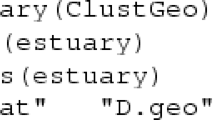Abstract
Earth scientists and land managers often wish to group sampling sites that are both similar with respect to their properties and near to one another on the ground. This paper outlines the geostatistical rationale for such spatial grouping and describes a multivariate procedure to implement it. Sample variograms are calculated from the original data or their leading principal components and then the parameters of the underlying functions are estimated. A dissimilarity matrix is computed for all sampling sites, preferably using Gower's general similarity coefficient. Dissimilarities are then modified using the variogram to incorporate the form and extent of spatial variation. A nonhierarchical classification of sampling sites is performed on the leading latent vectors of the modified dissimilarity matrix by dynamic clustering to an optimum. The technique is illustrated with results of its application to soil survey data from two small areas in Britain and from a transect. In the case of the latter results of spatially weighted classifications are compared with those of strict segmentation. An appendix lists a Genstat program for a spatially constrained classification using a spherical variogram as an example.
Similar content being viewed by others
References
Alvey, N. G.; Banfield, C. F.; Baxter, R. I.; Gower, J. C.; Krzanowski, W. J.; Lane, P. W.; Leech, P. K.; Nelder, J. A.; Payne, R. W.; Phelps, K. M.; Rogers, C. E.; Ross, G. J. S.; Simpson, H. R.; Wedderburn, R. W. M.; and Wilkinson, G. N., 1977, Genstat, a General Statistical Program: Rothamsted Experimental Station, Harpenden, 469 p.
Banfield, C. F. and Bassill, L. C., 1977, Algorithm AS113: A Transfer Algorithm for Non-Hierarchical Classification: Appl. Stat., v. 26, p. 206–210.
Berry, B. J. L., 1966, Essays on Commodity Flows and the Spatial Structure of the Indian Economy: Research Paper No. 111, Department of Geography, University of Chicago, 334 p.
Draycott, A. P.; Durrant, M. J.; Hull, R.; and Messem, A. B., 1977, Changes in Broom's Barn Farm Soils, 1960–75; Rothamsted Experimental Station Report for 1976, Part 2, p. 33–52.
Elphinstone, C. D.; Lonergan, A. T.; Fatti, L. P.; and Hawkins, D. M., 1985, An Empirical Investigation into the Application of Some Statistical Techniques to the Classification of Remotely Sensed Data: Special Report SWISK 40, National Research Institute for Mathematical Sciences, Pretoria, 91 p.
Ferligoj, A. and Batagelj, V., 1982, Clustering with Relational Constraint: Psychometrika, v. 47, p. 413–426.
Gower, J. C., 1966, Some Distance Properties of Latent Root and Vector Methods Used in Multivariate Analysis: Biometrika, v. 53, p. 325–338.
Gower, J. C., 1971, A General Coefficient of Similarity and Some of Its Properties: Biometrics, v. 27, p. 857–871.
Hawkins, D. M. and Merriam, D. F., 1974, Zonation of Multivariate Sequences of Digitized Geologic Data: Math. Geol., v. 5, p. 27–37.
Hawkins, D. M.; Muller, M. V.; and Krooden, J. A. ten, 1982, Cluster Analysis: p. 303–356in D. M. Hawkins (ed.), Topics in Applied Multivariate Analysis: Cambridge University Press, Cambridge.
Lance, G. N. and Williams, W. T., 1967, Mixed-Data Classification Programs. I. Agglomerative Systems: Aust. Comput. J., v. 1, p. 15–20.
MacQueen, J., 1967, Some Methods for Classification and Analysis of Multivariate Observations: Proceedings of the Fifth Berkeley Symposium on Mathematical Statistics and Probability, v. 1, p. 281–297.
Marriott, F. H. C., 1971, Practical Problems in a Method of Cluster Analysis: Biometrics, v. 27, p. 501–514.
Marriott, F. H. C., 1974, The Interpretation of Multiple Observations: Academic Press, London, 117 p.
Matheron, G. 1965. Les Variables Régionlisées et leur Estimation: Masson, Paris, 305 p.
McBratney, A. B. and Webster, R., 1981, Spatial Dependence and Classification of the Soil Along a Transect in North East Scotland: Geoderma, v. 26, p. 63–82.
McBratney, A. B. and Webster, R., 1986, Choosing Functions for Semi-Variograms and Fitting Them to Sampling Estimates: J. Soil Sci., v. 37, p. 617–639.
Oliver, M. A. and Webster, R., 1987a, The Elucidation of Soil Pattern in the Wyre Forest of the West Midlands, England. I. Multivariate Distribution: J. Soil Sci., v. 38, p. 279–291.
Oliver, M. A. and Webster, R., 1987b, The Elucidation of Soil Pattern in the Wyre Forest of the West Midlands, England. II. Spatial Distribution: J. Soil Sci., v. 38, p. 293–307.
Openshaw, S., 1977, A Geographical Solution to Scale and Aggregation Problems in Region-Building, Partitioning and Spatial Modelling: Transactions of the Institute of British Geographers, v. 2, p. 459–472.
Perruchet, C., 1983, Constrained Agglomerative Hierarchical Classification: Pattern Recognition, v. 16, p. 213–217.
Spence, N. A., 1968, A Multivariate Uniform Regionalization of British Counties on the Basis of Employment Data for 1961: Reg. Stud., v. 2, p. 87–104.
Webster, R., 1973, Automatic Soil Boundary Location from Transect Data: Math. Geol., v. 5, p. 27–37.
Webster, R., 1977, Quantitative and Numerical Methods in Soil Classification and Survey: Clarendon Press, Oxford, 269 p.
Webster, R., 1978, Optimally Partitioning Soil Transects: J. Soil Sci., v. 29, p. 388–402.
Webster, R. and Burrough, P. A., 1972, Computer-Based Soil Mapping of Small Areas from Sample Data. II. Classification Smoothing: J. Soil Sci., v. 23, p. 222–234.
Webster, R. and Cuanalo de la C., H. E., 1975, Soil Transect Correlograms of North Oxfordshire and Their Interpretation: J. Soil Sci., v. 26, p. 176–194.
Webster, R. and McBratney, A. B., 1987, Mapping Soil Fertility at Broom's Barn by Simple Kriging: J. Sci. Food Agric., v. 38, p. 97–115.
Author information
Authors and Affiliations
Rights and permissions
About this article
Cite this article
Oliver, M.A., Webster, R. A geostatistical basis for spatial weighting in multivariate classification. Math Geol 21, 15–35 (1989). https://doi.org/10.1007/BF00897238
Received:
Accepted:
Issue Date:
DOI: https://doi.org/10.1007/BF00897238




